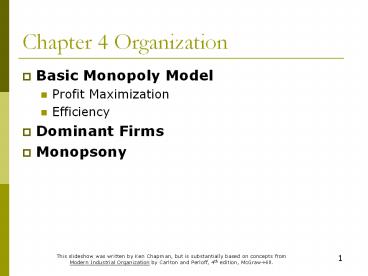This slideshow was written by Ken Chapman, but is substantially based on concepts from Modern Industrial Organization by Carlton and Perloff, 4th edition, McGraw-Hill. PowerPoint PPT Presentation
Title: This slideshow was written by Ken Chapman, but is substantially based on concepts from Modern Industrial Organization by Carlton and Perloff, 4th edition, McGraw-Hill.
1
Chapter 4 Organization
- Basic Monopoly Model
- Profit Maximization
- Efficiency
- Dominant Firms
- Monopsony
2
Single Price Monopoly
- Assumptions
- Single Good
- One firm with no threat of entry
- Charges the same price for all units of the
product - Maximizes Profit
3
Graphing Profit Maximization
- Inverse Demand Curve P 100 2Q
- Cost 25 10q q2
TR, Profit
Price
1375
1250
1000
875
750
625
500
375
250
125
q
q
0
4
Calculations
- Inverse Demand Curve P 100 2Q
- Cost 25 10q q2
5
Calculations
- Inverse Demand Curve P 100 2Q
- Cost 25 10q q2
6
Calculations
- Inverse Demand Curve P 100 2Q
- Cost 25 10q q2
7
Monopoly Profit, Deadweight Loss
- Inverse Demand Curve P 100 Q
- Cost 50q
P
100
75
MC
50
Q
25
100
50
MR
8
Calculations
- Inverse Demand Curve P 100 Q
- Cost 50q
9
Monopoly Markup
10
Incentives for Efficient Operation
- X-inefficiency
- Rent-seeking
- Deadweight Loss and Elasticity
- Benefit of a monopoly
- Economies of scale
- Network effects
- Patents and technological development
11
Creating and Maintaining Monopoly
- Knowledge advantage
- Controlling a key ingredient
- Government
- Natural Monopoly
- Strategic Devices
- Incumbent Reactions
- Specific Assets
- Scale Economies
- Reputation Effects
- Excess Capacity
- Incumbent Advantages
- Pre-commitment Contracts
- Licenses and Patents
- Learning-Curve Effects
- Pioneering Brand Advantages
12
Profit and monopoly
- Is any firm that earns a profit a monopoly?
- Does a monopoly always earn a positive profit?
13
Can a monopoly have profit lt0?
- Inverse Demand Curve P 100 Q
- Cost 50q
P
100
75
MC
50
Q
25
100
50
MR
14
Dominant Firm with a Competitive Fringe
- Why are some firms dominant?
- Efficiency
- Patents
- Early Entry
- Government Favoritism
- Network Effects
15
The No-Entry Model
- Assumptions
- The large firm has lower production costs than
the other firms - All firms, except the dominant firm, are price
takers. - The dominant firm knows the demand curve
- The dominant firm can predict how much the fringe
will produce at any price.
16
Figure 4.6 Dominant Firm Fringe
Supply from the Fringe, S(p)
/q
/q
Demand, D(p)
Demand, D(p)
q
Q
Monopoly MR
17
Example
- Inverse market demand P 1000-Q
- Inverse Fringe Supply P 700 Qf
18
Example
- Inverse market demand P 1000-Q
- Inverse Fringe Supply P 700 Qf
19
Figure 4.6 Dominant Firm Fringe
Supply from the Fringe, S(p)
/q
/q
Demand, D(p)
Demand, D(p)
q
Q
Monopoly MR
20
Figure 4.6 Dominant Firm Fringe
Supply from the Fringe, S(p)
/q
/q
MR Dominant Firm
Demand, D(p)
Demand, D(p)
q
Q
Monopoly MR
21
Figure 4.6 Dominant Firm Fringe
Supply from the Fringe, S(p)
/q
/q
MR Dominant Firm
Demand, D(p)
Demand, D(p)
q
Q
22
Monoposony
- Single buyer
- Sellers are price takers
23
Monopsony
- Marginal Revenue Product of Labor 100 L
W
Supply W L
100
MRPL 100 - L
L
25
50
100
24
Monopsony Workspace
25
Monopsony Workspace

